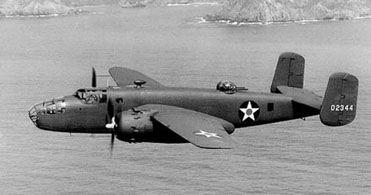B-25B-NA
History
The B-25 was proving itself in training as the United States was getting closer to entering the war. North American completed the NA-62 contract with the B-25B-NA. B-25-NA and B-25A-NA models were not well defended with a couple of "pea shooters" and a single .50 caliber gun in the rear. It was time to prepare the B-25 for war. The tail gun position was eliminated along with the armor added to protect the gunner. Two Bendix turrets were added in the rear fuselage. The top turret would house two .50 caliber guns. A retractable bottom turret would also contain two .50 caliber guns. The turrets allowed for on gunner to fire in just about any direction. The upgrade from one .50 caliber gun to 4 was a welcome one.
Addition of the two turrets increased the drag on the plane. To minimize this effect, the lower turret was retractable. This design proved problematic as the mechanism was prone to jamming in the down position. From a gunner's standpoint, it was hard to operate and many would suffer from vertigo while using it. As a consequence, the lower turret was often removed in the field. Despite this, the lower turret design would remain on the B-25 for the B-25C-NA and B-25D-NC models.
The B-25B-NA was the first B-25 that went to war. It is worth noting that the Doolittle Raiders flew modified B-25B-NA bombers. The B-25 was small enough to fit on an aircraft carrier and powerful enough to take off from one. This made it the perfect choice for one of the most daring attacks of the war. The first 184 B-25s were now proving their worth on the battlefield as demand for more was increasing. The B-25B-NA can be easily distinguished from previous models by noting the two aft turrets, open tail skid, and single .30 caliber gun placed in the plexiglass nose.
B-25B-NA Specs |
- Model: B-25B-NA
- Total Produced: 120
- Manufacturing Plant: Inglewood, California
- First Test Flight: Between February and November 1941
- First Flight Crew: unknown
- Engines: Wright R-2600-9
- Carburetors: Bendix Stromberg PD-13E-2
- Fuel Capacity:
- 2 forward wing cells, total 368 gallons
- 2 rear wing cells, total 324 gallons
- Droppable bomb bay tank 420 gallons
- Armament:
- 1 flexible .30 caliber gun in nose
- 2 .50 caliber guns in top Bendix turret
- 2 .50 caliber guns in bottom Bendix turret
- Armor Protection: 3/8 inch plate behind pilots and bombardier, under bombardier
- Weights:
- Empty: 20,000 lbs.
- Max: 28,460 lbs.
- Speed (Max): 300 mph at 15,000 feet
- Service Ceiling: 23,500 ft
- Range: 1,300 miles with 3,000 lbs. bombs
- Crew:
- Pilot, co-pilot, bombardier, navigator/radio operator, gunner
- Production by year:
- 1941: 107
- 1942: 13
- First Airplane Accepted: August 6, 1941
- Last Airplane Accepted: May 27, 1942
| Model | NAA Contract | SN | NAA # | # Produced |
|---|---|---|---|---|
| B-25B-NA | NA-62 | 40-2229/40-2348 | 62-2898/62-3017 | 120 |
- NAA Contract:
- NA-62 signed September 5, 1939
- Major Visual Production Block Changes:
- Removal of rear .50 caliber gun
- Addition of top and bottom turrets in rear fuselage
- Notable Aircraft:
- 40-2347 the only "surviving" B-25B-NA airframe.
- 40-2344, 40-2292, 40-2270, 40-2282, 40-2283, 40-2298, 40-2261, 40-2242, 40-2303, 40-2250, 40-2249, 40-2278, 40-2247, 40-2297, 40-2267, 40-2268 Collectively, the Doolittle Raid planes in order of their take-off from the U.S.S. Hornet.




